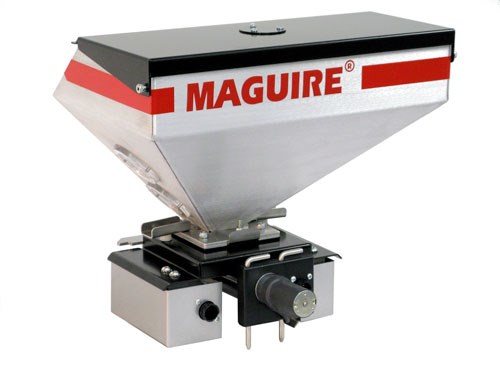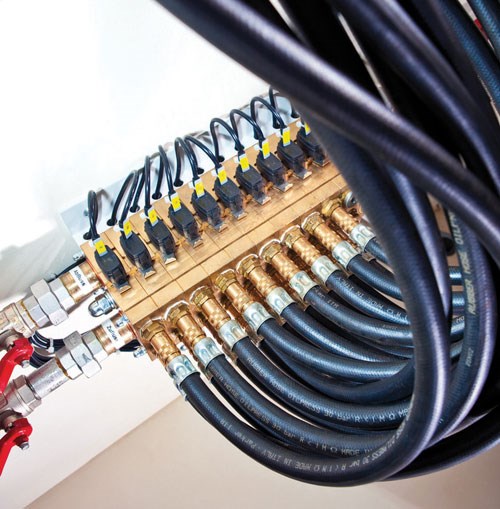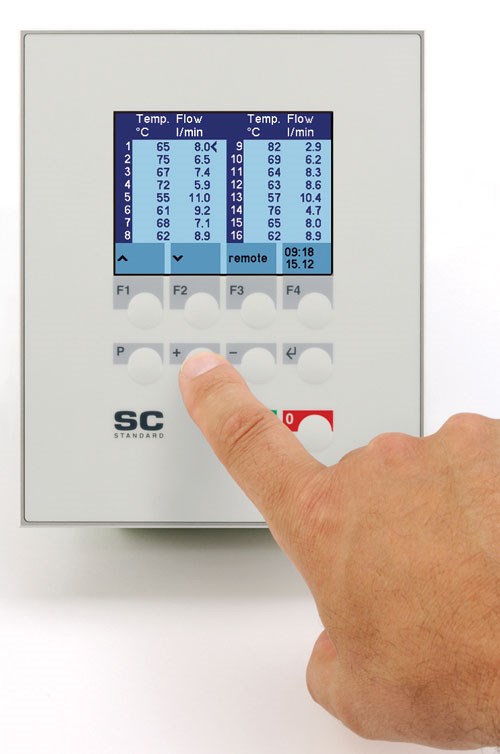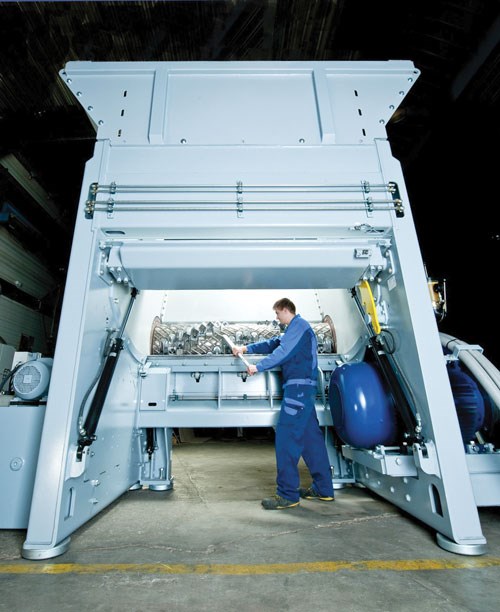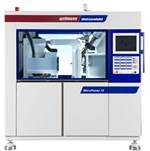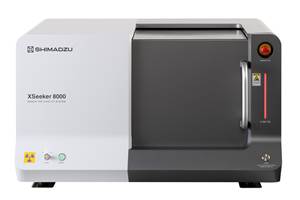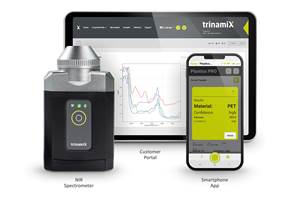K 2010 Preview, Auxiliaries: Equipment of All Types Debuts This Month at K 2010
From materials drying, feeding, and blending to process heating/cooling, scrap reclaiming, testing, welding, and decorating—the K 2010 show this month in Dusseldorf, Germany, will have news in all categories of auxiliary equipment.
From materials drying, feeding, and blending to process heating/cooling, scrap reclaiming, testing, welding, and decorating—the K 2010 show this month in Dusseldorf, Germany, will have news in all categories of auxiliary equipment. Here are brief previews of new entries revealed before the show.
BLENDING, FEEDING, DRYING
Maguire Products, Inc., Aston, Pa. (maguire.com), says the new advanced model of the MGF gravimetric feeder for colorants and additives more than doubles the throughput of the original system while retaining the same compact size and price advantage. The new system has a smaller motor but delivers up to 80 lb/hr vs. the previous limit of 30 lb/hr. Yet it still costs the same as volumetric feeders and nearly 40% less than competing gravimetric models, Maguire says. Also new is a networking option for the MGF controls: Maguire’s Gravimetric Gateway (G2) software, used with its weigh-scale blenders, provides detailed material usage reports, displays alarms from anywhere in the network, allows remote access, and monitors inventory levels.
Three new developments will be presented by Koch-Technik in Germany (koch-technik.com), represented here by Yellowbox Technologies, Union, Ky. (yellowboxengineering.com). One is the Exako gravimetric direct-dosing device for use on injection machines. It combines gravimetrics with the enclosed-chamber volumetric dosing method to meter tiny quantities (1 to 55 g) accurately. A new touchscreen control stores recipes. There’s also a new MCm-G Touch control for the Graviko gravimetric blenders.
In drying, Koch-Technik is bringing out its first compressed-air dryers, designed for machine mounting and processing up to 15 lb/hr. Another new dryer is the Drymax Aton wheel model from Wittmann Battenfeld, Torrington, Conn. (wittmann-battenfeld.com). Unlike other wheel dryers, which have desiccant bound to the wheel’s surface, the Drymax Aton wheel has a series of chambers housing loose molecular-sieve desiccant—the same type used in conventional desiccant-bed dryers. This is said to provide better air circulation through the desiccant, saving energy, and also means the desiccant can be replaced without replacing the wheel itself—a major cost saving. The dryer has two modes of operation—continuously rotating wheel mode and low-energy EcoMode for occasions when only a low level of drying is needed. In this “quasi-2-bed mode,” the wheel stops turning and several segments are combined to operate simultaneously, while regeneration heating operates only half the time. This unit will be available here after the show.
And for high-volume PET drying (up to 17,600 lb/hr), Moretto S.p.A. of Italy (moretto.com) will unveil its Eureka Project, combining the new X Max dryer, Flomatik controller, and brand-new OTX hopper—all designed to save energy and dramatically cut drying times. As we reported in June, this system involves several new technical approaches, which are offered to processors at no upfront cost, with subsequent payments based on energy savings.
Meanwhile, Bunting Magnetics, Newton, Kan. (buntingmagnetics.com), has launched what it calls a breakthrough in metal separation for injection molders. Its all-new Neo FF Series drawer magnet uses high-strength, high-temperature neodymium magnets that can catch and hold ferrous particles too small to be seen by the naked eye. “This exceptional level of magnetic metal separation,” says Bunting, “means less downtime, reduced screw wear, and fewer plugged hot-runner nozzles.”
Pelletron Corp., Lancaster, Pa. (pelletroncorp.com) will show its DeDuster for cleaning dust and fines from pellets and regrind in two new versions. The OS-DeDuster has an offset inlet and outlet for installation in existing pipes without changing the pipe geometry in tight spaces. The RC-DeDuster is a round model with lower height than any previous model.
HEATING/COOLING
Single Temperature Controls in Germany (U.S. office in Charlotte, N.C.) will present a new pressurized hot-water mold TCU for temperatures up to 225 C/437 F in molding resins like PEEK. Water has better heat-transfer properties than hot oil and can be used in clean rooms. This 6-kW unit has flow rates up to 7.9 gpm.
Single (single-temp.com) also will show the recently introduced SWV water manifold with integral flow metering. It allows process monitoring based on flow rate and temperature of each of up to 32 water circuits (see photos, p. 13).
Both Single and Wittmann Battenfeld have brought out hot-water units for micro-molding. Single’s new Micro unit is designed for consistent temperature control of molds with micro-runners of 1 to 3 mm diam. It provides flow rates of 0.3 to 0.5 gpm at pressures up to 116 psi. And Wittmann’s Tempro-Plus-D-Micro 100 TCU with two circuits, direct or indirect cooling, heating capacity of 1 to 6 kW, and pump output of 3.2 to 7.9 gpm is one of several new auxiliaries designed for integration within the frame of its new MicroPower micro-molding presses (see Learn More). It will become available here after the show.
Wittmann also has new water-flow regulators with flow control and non-contact flow measurement for each serial or parallel circuit with a digital display. The WFC 100 handles up to 100 C/212 F and the WFC 160 is for up to 160 C/320 F. Both provide 2 to 40 liters/min per circuit. (Not available in the U.S. until after K.)
SCRAP RECLAIM
Wittmann has filled a gap in its granulator size range with the new MC34 Primus central unit with 11.7 x 15.6 in. cutting chamber and throughput of up to 660 lb/hr. It’s the first of the new MC Primus series for soft to medium-hard plastics, intended as a bridge between Wittmann’s ML line of beside-the-press and MC line of central granulators (available here after the show).
Lindner resource GmbH of Germany (Lindner America is in Raleigh, N.C.) is bringing out new single-shaft shredders in three sizes designed for low energy consumption and high productivity. The Micromat Plus series is designed for flexibility and quick changeovers. Lindner (linder-resource.com) offers three different drive types—standard belt drive, high-torque version, and direct drive—designed for different types of scrap. Rotor and blade combinations can be customized, as well. There are square and point-blade rotors with five blade sizes and blade carriers that can be used four times. All models have a new, large inspection and maintenance hatch that opens inward by hydraulic action for access to the rotor and bed knives. The redesigned screen area has screens with 10- to 300-mm hole sizes and a screen basket that opens hydraulically. All units have PLC control and optional touchscreen.
TESTING INSTRUMENTS
Instron, Norwood, Mass. (instron.com), will bring several new developments to K. The Instron 5969 is part of the new, highly ergonomic and adaptable series 5900 tensile testing systems. This dual-column tabletop model is for mid-range test loads of up to 50 kN, with crosshead travel of 1140 mm and max. speed of 600 mm/min. At the show, it will feature new pneumatic grips with jawface shields that are easily adjustable for different sample shapes and quickly changeable without tools. Instron will also show its new automatic carousel system for automated, multi-sample testing on the series 5900.
In addition, new Bluehill 3 testing software is adapted to low-speed tasks like bending or tension tests. It is even easier to use than previous versions, with many pre-configured testing tasks and reports, though customized tests can easily be added. One time saver is eight task-specific application modules for plastics, elastomers, glues, etc.
Also new is the DAS 64K data-acquisition system for Ceast pendulum and falling-weight impact testers. It has four data channels and storage capacity of 64,000 sample points for high-resolution analysis.
Instron also will bring the new Ceast MMF 7028 multi-weight, precision melt-flow tester, which can test up to five weights in any sequence with touchscreen control. It complies with the greater demands of the upcoming ISO/DIS 1133 T.2 test standard.
The new Aflow extrusion plastometer (melt indexer) from Zwick Roell (U.S. office in Atlanta) uses programmed force instead of weights to control stepless adjustment of test loads up to 50 kg. Designed for high-throughput labs, it is cleaned at the push of a button.
Also from Zwick (zwick.com) is the new roboTest H for automated Charpy or Izod impact tests on plastics at or below room temperature. It automates delivery of the specimen to the support, specimen alignment, and hammer release.
Atlas Material Testing Technology LLC, Chicago (atlas-mts.com) will feature new UV/weather testing systems. Its Suntest XXL+ and XLS+ and Xenotest Beta+ have new XenoTouch software features such as remote control, email, and online monitoring, which enable users to operate and control instruments in distant locations. These features are standard on new units and are retrofittable.
Atlas is now making available globally its Sepap system that was previously sold only in France. This is an affordable device for accelerated photo-aging of polymers. Meanwhile, the new UVTest system is said to provide greater ease of use, accuracy, and safety than competing fluorescent UV-exposure devices. It also controls temperature and moisture.
LASER & HYBRID WELDING
LPKF Laser & Electronics AG (lpkf.com, U.S. office in Tualatin, Ore.) will show off the latest evolution of its TwinWeld 3D hybrid welding system, introduced at K 2007. It combines laser and infrared welding in a single head to join large 3D parts without tools and with ability to compensate for dimensional variances. The newest head is much more compact than before, as is the overall footprint.
Also, Fraunhofer ILT (Institute for Laser Technology) in Germany (ilt.fraunhofer.de) will present a new approach to laser welding that requires no costly infrared absorber in one of the joint components. Called TransTwist, it is aimed at precision welding of biomedical microfluidics and packaging. Fraunhofer USA’s Center for Laser Technology (CLT) is in Plymouth, Mich. (clt.fraunhofer.com).
IML & FOIL DECORATING
The German parent of Kurz Transfer Products in Charlotte, N.C. (kurzusa.com), is presenting something different in heat-transfer decorating. New HP Topcoat is a thermoplastic lacquer transferred from a roll by hot stamping to protect plastics from abrasion and chemicals. This completely dry process replaces wet chemicals. If applied to flat sheets, HP (High Performance) Topcoat can be deep-drawn in thermoforming. Another alternative is UP (Ultra Performance) Topcoat, which is UV cured after transfer to provide extra scratch resistance to furniture, washing-machine panels, and refrigerator doors.
Also new from Kurz is Colorit High Resistance stamping foil for outdoor applications that must resist weather and high wear and tear. Uses include beverage crates, trash cans, pallets, tubs, and buckets.
Kurz is also exhibiting a range of tactile “structured” foils to meet the current fashion for auto interiors, plus pigmented metallic foils with glossy, matte, or brushed surfaces for notebook computers and other mobile electronic devices.
In addition, the German parent of Proell, Inc., St. Charles, Ill. (proell.de), has new Noriphan XWR screen printing inks for creating in-mold labels and decorations. These halogen-free, two-component inks for PC and PET films reportedly show extremely high washout resistance and outstanding cohesion in multicolor printing. Other news from Proell includes Mirror Ink M3, a chrome-effect screen-printing ink with improved weather resistance.
Related Content
Comprehensive Optical Inspection for PET Preforms
Delta Engineering teams with Intravis to inspect preform mouth, body, thread and color.
Read MoreX-Ray Vision Inside Parts Gets More Affordable for Processors
Shimadzu’s new benchtop x-ray CT scanner provides internal and external metrology and flaw detection at a fraction of the previous cost.
Read MoreRedesigned Laser Scanner Boasts Improved Accuracy, Resolution, Versatility, and Efficiency
Nikon Metrology’s new LC15Dx is ideal for efficient measurement and inspection of manufactured components including intricate plastic parts.
Read MoreHandheld NIR Instrument Distinguishes PET from PETG
Mobile spectroscopy from trinamiX detects more than 30 different plastics—and now PET vs. PETG as an aid to recycling.
Read MoreRead Next
New Machines & Processes Unveiled By Wittmann Battenfeld
At an open house in Kottingbrunn, Austria, last month, Wittmann Battenfeld GmbH showed what it has been doing to make good on its pledge to reinvigorate the venerable Battenfeld name and its reputation for innovation.
Read MoreTroubleshooting Screw and Barrel Wear in Extrusion
Extruder screws and barrels will wear over time. If you are seeing a reduction in specific rate and higher discharge temperatures, wear is the likely culprit.
Read MoreWhy (and What) You Need to Dry
Other than polyolefins, almost every other polymer exhibits some level of polarity and therefore can absorb a certain amount of moisture from the atmosphere. Here’s a look at some of these materials, and what needs to be done to dry them.
Read More


